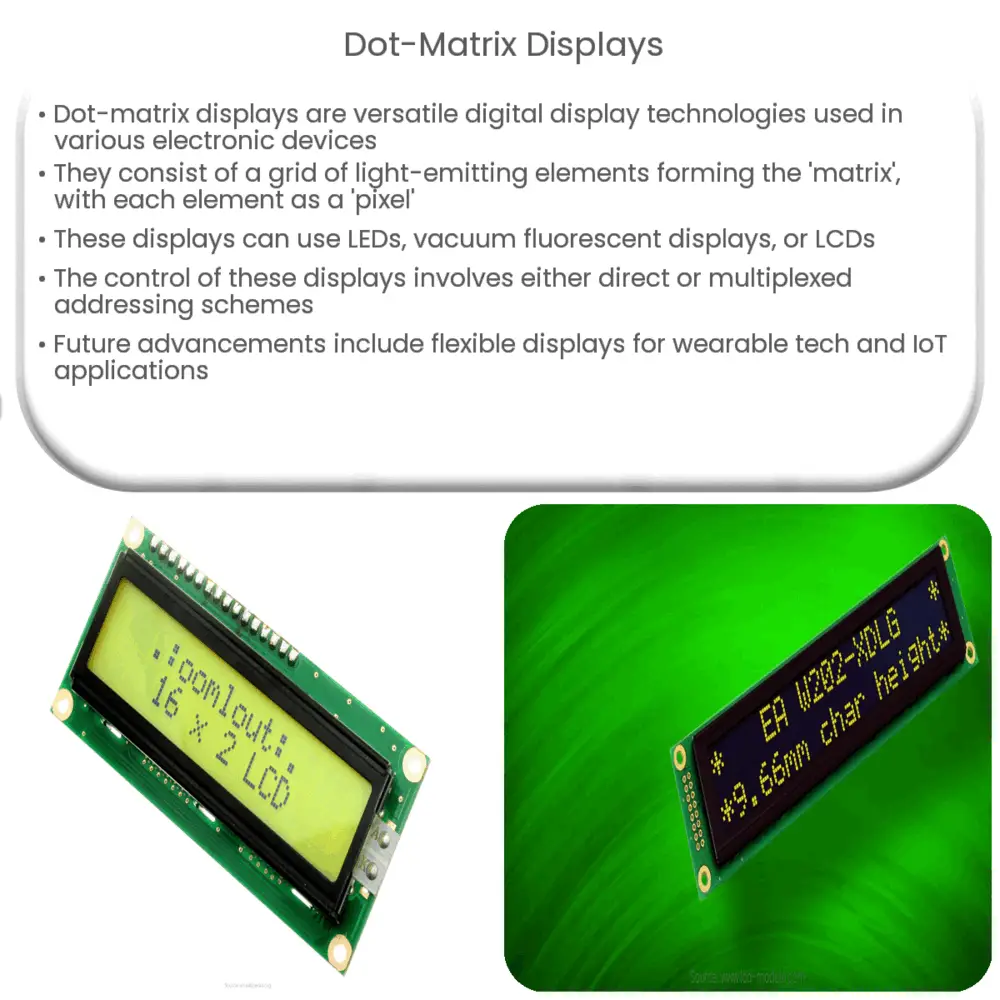Explore the world of dot-matrix displays: their operation, types, applications, evolution, pros, cons, and future prospects in the digital age.

Understanding Dot-Matrix Displays
Dot-matrix displays, often found in electronic devices such as clocks, calculators, and information boards, are unique digital display technologies. They offer a versatile solution for displaying different types of data, such as text, graphics, and custom symbols, making them exceptionally useful across a wide range of applications.
Construction and Operation
A dot-matrix display is comprised of a grid of light-emitting elements—these can be LEDs (Light Emitting Diodes), vacuum fluorescent displays, or even LCDs (Liquid Crystal Displays). Each individual light-emitting element is referred to as a ‘pixel’ or a ‘dot’, and these dots collectively form the ‘matrix’. The presence or absence of light from each pixel forms characters or graphics on the screen.
- LED Dot-Matrix Display: This type of dot-matrix display uses light-emitting diodes as pixels. The LEDs are arranged in rows and columns, allowing for a large number of display configurations. They are easy to use, durable, and highly visible even in bright light conditions.
- Vacuum Fluorescent Display (VFD): These are primarily used in consumer electronics and automotive displays due to their high brightness, wide viewing angles, and high contrast. Each dot in a VFD is a phosphor anode coated with a thin layer of graphite for improved electron emission.
- LCD Dot-Matrix Display: LCD dot-matrix displays are commonly found in handheld electronic devices due to their low power consumption. Each pixel in an LCD display is controlled by a transistor, allowing individual pixels to be turned on or off.
Addressing and Driving Schemes
The control of dot-matrix displays relies on two primary addressing schemes: direct and multiplexed. In a direct drive scheme1, each dot has a dedicated input line. Conversely, the multiplexed scheme2 has dots grouped into rows and columns, with each row and column having a dedicated input line. As the complexity and size of the display increase, the multiplexed scheme becomes more beneficial.
Applications of Dot-Matrix Displays
Dot-matrix displays have a multitude of uses across various sectors. They are a ubiquitous component in digital watches and clocks, railway departure indicators, and electronic billboards. In the automotive industry, dot-matrix displays are often used for instrument cluster panels, and in the medical industry, they can be found in devices such as patient monitors.
The Evolution of Dot-Matrix Displays
Dot-matrix technology has evolved significantly since its inception, moving from simple LED displays to more complex LCD and vacuum fluorescent displays. Today, many dot-matrix displays feature advanced capabilities, such as color displays and high-definition resolution. This ongoing development has broadened the scope of applications for dot-matrix displays, allowing for more visually rich and diverse digital displays.
Advantages and Disadvantages
There are several advantages to using dot-matrix displays, including their versatility, low power consumption, and long lifespan. Their ability to display both text and graphics makes them suitable for a wide range of applications. However, they also have a few limitations, such as a lower resolution compared to other types of displays, limited viewing angles, and potential for burn-in, which is when static images are displayed for extended periods of time and can cause damage to the display.
Future of Dot-Matrix Displays
The future of dot-matrix displays is likely to involve even greater advancements in technology. There are already developments in flexible and bendable dot-matrix displays, opening up new possibilities for wearable technology and other innovative applications. Similarly, the rise of smart homes and Internet of Things (IoT) devices is likely to further increase the demand for versatile, low-power display technologies like the dot-matrix display.
Conclusion
In conclusion, dot-matrix displays are a versatile and reliable display technology, with a multitude of applications across various industries. Their simplicity in design and operation makes them a popular choice for many electronic devices. While they have some limitations, ongoing technological advancements continue to improve their capabilities, resolution, and overall performance. The future of dot-matrix displays promises exciting developments as they become increasingly integrated into new technological applications, from wearable devices to smart home systems. Despite the rise of other digital display technologies, the dot-matrix display remains a key player in our digital world.

